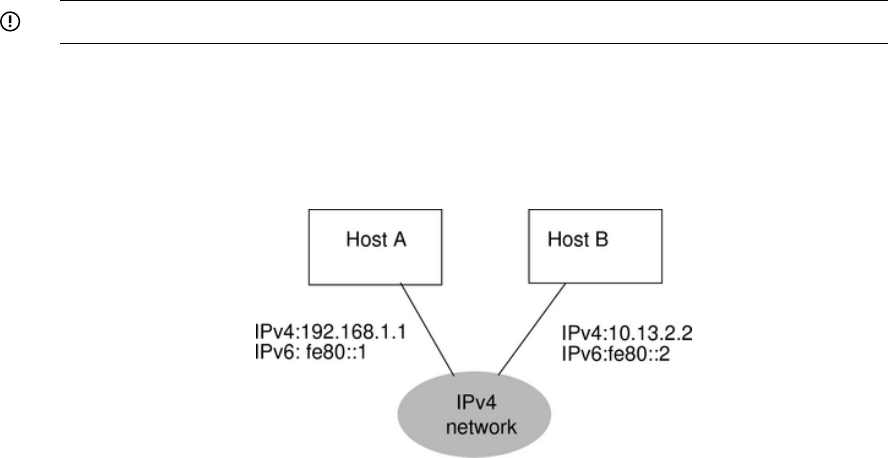HP-UX IPv6 Transport Administrator Guide HP-UX 11i v3 (5992-6426, May 2013)
Table Of Contents
- HP-UX IPv6 Transport Administrator Guide
- Contents
- About This Document
- 1 Features Overview
- IPv6 Transport
- New IPv6 Transport Features
- Support for RFC 3542 (Advanced Sockets API for IPv6)
- Configurable Policy Table Support
- Anycast Address Support
- Support for RFC 4291 (IP Version 6 Addressing Architecture)
- Support for RFC 4213 (Basic Transition Mechanisms for IPv6 Hosts and Routers)
- Support for RFC 3484 (Default Address Selection for Internet Protocol version 6 (IPv6))
- Support for RFC 3493 (Basic Socket Interface Extensions for IPv6)
- Support for RFC 4584 (Extension to Sockets API for Mobile IPv6)
- Support for RFC 4193 (Unique Local IPv6 Unicast Addresses)
- Support for RFC 4443 (Internet Control Message Protocol for IPv6 (ICMPv6))
- Support for IPv6 over VLAN
- Ability to Disable Autoconfiguration Based on Router Advertisements
- Support for RFC 3810 (Multicast Listener Discovery Version 2 (MLDv2))
- Support for RFC 3376 (Internet Group Management Protocol Version 3 (IGMPv3))
- Support for RFC 3678 (Socket Extension to Multicast Source Filter API)
- Support for RFC 4941 (Privacy Extensions for Stateless Address Autoconfiguration in IPv6)
- New ndd Tunables
- IPv6 Transport Features Available in the Core HP-UX 11i v3 Operating System
- Limitations
- IPv6 Transport
- 2 Configuration
- Configuring IPv6 Interfaces and Addresses
- Stateless Autoconfiguration
- Manual Configuration
- Configurable Policy Table for Default Address Selection for IPv6
- Host Names and IPv6 Addresses
- 3 Troubleshooting
- 4 IPv6 Addressing and Concepts
- 5 IPv6 Software and Interface Technology
- 6 Utilities
- A IPv6 ndd Tunable Parameters
- Index

— Tunnel exit-point node (remote) address: This is the tunnel destination address. For
“ip6inip” it will be a link-local IPv6 address configured (automatically if not specified)
from the destination address in the encapsulating (outer) header. For “6to4” this
value must never be specified, since it will always be automatically determined
based on routing information.
— Source address in the encapsulating (outer) header: This must be an address
configured on an interface on the tunnel entry-point (local) node. For “ip6inip ” and
“6to4” it must be an IPv4 address.
— Destination address in the encapsulating (outer) header: This must be an address
configured on an interface on the tunnel exit-point (remote) node. For “ip6inip” it
must be an IPv4 address. For “6to4” this value must never be specified, since it will
automatically be derived from the destination “6to4” address.
— Interface State: Specifies the desired interface state, “up” or “down”. By default it
is “up”.
— Interface Flag: Specify interface flag. If set to “-private”, disable stateless address
autoconfiguration using prefixes received in router advertisements. Default is
“private”, the interface will autoconfigure addresses using prefixes received in router
advertisements.
Automatic tunnels are point-to-multipoint tunnels. The IETF has deprecated automatic
tunnels with IPv4-compatible address in favor of “6to4”. For more information on “6to4”,
refer to ““6to4” - Connecting IPv6 Domains over IPv4 Clouds” (page 59) of this guide.
IMPORTANT: Automatic tunnels with IPv4-compatible addresses are not supported.
Configured Tunnel IP6-in-IP Tunnel (Host-Host) Example
This section provides an example of how to configure a simple IP6-in-IP configured tunnel
between two dual stack hosts both running HP-UX 11i v3.
Figure 11 Host-Host Configured Tunnel
Figure 11 illustrates a scenario where you can set up a configured tunnel between Host
A and Host B.
56 IPv6 Software and Interface Technology










